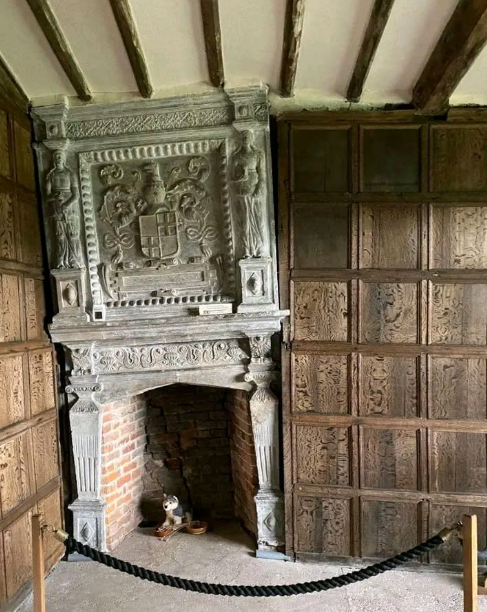Nestled in Cheshire, England, Little Moreton Halls is a fascinating Tudor manor house that has captured visitors for centuries. One of its most peculiar features is its fireplace, which appears crooked at first glance. However, closer inspection reveals a surprising truth: the fireplace is perfectly straight—it’s the rest of the room that’s out of alignment. This unique quirk makes Little Moreton Halls one of the most delightfully eccentric historical buildings in England. Let’s explore this oddity with archeology.dulichvn.net through the following article.
A Masterpiece of Tudor Architecture
The Construction of Little Moreton Halls
Little Moreton Halls was constructed between 1504 and 1610 CE, embodying the architectural styles and craftsmanship of the Tudor period. It is a timber-framed building, renowned for its intricate patterns of black and white woodwork, expansive leaded windows, and sloping lines that defy modern expectations of symmetry.

The house was originally built as a statement of wealth and status by the Moreton family. Over time, the structure underwent several expansions, resulting in the uniquely uneven aesthetic that defines it today.
A deliberate quirk or structural shift?
The apparent wonkiness of Little Moreton Halls is not intentional. Over the centuries, the building’s wooden framework has warped and shifted due to natural settling, soil movement, and the weight of its upper stories. This gradual distortion gives the hall its quirky charm, with tilted windows, uneven floors, and, most famously, a fireplace that appears to defy logic.
See more: John Candy and Dan Aykroyd: A Legendary Pair on the Set of The Great Outdoors (1987)
The Fireplace: A Testament to Structural Integrity
Why Does the Fireplace Look Crooked?
The fireplace in Little Moreton Halls is a prime example of how the building’s uneven framework plays tricks on the eyes. When viewed in the context of the slanted beams and leaning walls, the fireplace seems to be off-kilter. However, a spirit level or precise measurement confirms that it remains perfectly straight.

This anomaly occurs because the surrounding room has shifted over time, causing the beams and floors to slope. The fireplace, built from sturdy stone and brick, has resisted the forces that have distorted the rest of the structure.
Engineering Marvels of the Tudor Period
The craftsmanship behind the fireplace highlights the engineering ingenuity of the Tudor period. Built to last, the fireplace has withstood centuries of wear and tear, standing as a testament to the skill of the artisans who constructed it. Despite the warped surroundings, it remains functional, showcasing how durability and design coexisted in Tudor architecture.
A Visitor’s Delight
For visitors, the fireplace is a source of fascination and amusement. It serves as a visual metaphor for the hall’s overall charm—unexpected, quirky, and steeped in history. Many guests find themselves captivated by the optical illusion and marvel at the intersection of historical craftsmanship and natural wear.
Little Moreton Halls: A Living Museum
Step Back in Time
Little Moreton Halls offers visitors a rare opportunity to step into the past. Each room tells a story, with uneven floors, sagging ceilings, and the infamous fireplace adding to its authenticity. The hall is often described as a “living museum,” where every creak of the floorboards and every slanted windowpane speaks of its centuries-old journey.

Guided Tours and Insights
Expert guides provide insights into the hall’s history, architecture, and the quirks that make it unique. Visitors learn not only about the Tudor era but also about the ongoing preservation efforts that ensure Little Moreton Halls remains standing for future generations.
Interactive Experiences
To enhance the experience, the hall often hosts interactive exhibits and events, allowing guests to immerse themselves in Tudor life. From cooking demonstrations to period reenactments, these activities bring the past to life within the wonky walls of this extraordinary building.
See more: Status of Tutankhamun A Testament to Ancient Egyptian Beliefs
The Enduring Charm of England’s Wonkiest Building
An Icon of Historical Preservation
Little Moreton Hall is more than just a quirky architectural marvel; it is a symbol of the importance of historical preservation. Despite its imperfections—or perhaps because of them—the hall remains a beloved landmark, drawing thousands of visitors each year.

Inspiring Future Generations
The hall’s unique character has inspired artists, architects, and historians alike. Its ability to stand the test of time, even with its structural quirks, serves as a reminder of the ingenuity and resilience of past generations.
A National Treasure
As one of the best-preserved examples of Tudor architecture in England, Little Moreton Hall holds a special place in the country’s cultural heritage. Its wonky fireplace and other peculiar features make it an enduring treasure that continues to enchant all who visit.
Conclusion
Little Moreton Hall is a delightful anomaly, blending historical significance with architectural whimsy. Its famously straight fireplace, surrounded by an undeniably crooked room, is a testament to the hall’s unique charm and enduring legacy. Visitors are drawn to its uneven floors, leaning walls, and the stories they tell of a bygone era.
Whether you’re an architecture enthusiast, a history buff, or simply someone who appreciates the unexpected, Little Moreton Hall offers a truly unforgettable experience. Its wonky fireplace stands not just as a structural curiosity but as a symbol of the hall’s character—perfectly imperfect and wholly captivating.

CÁC TIN KHÁC
Mary Walton: The Forgotten Inventor Who Helped Clean Up America’s Cities
Tomb of Queen Nefertari in the Valley of the Queens, Egypt
Discover the Hypostyle Hall of the Temple of Hathor at Dendera
Venus de Losange: Unveiling the Mystery of a 20,000-Year-Old Paleolithic Icon